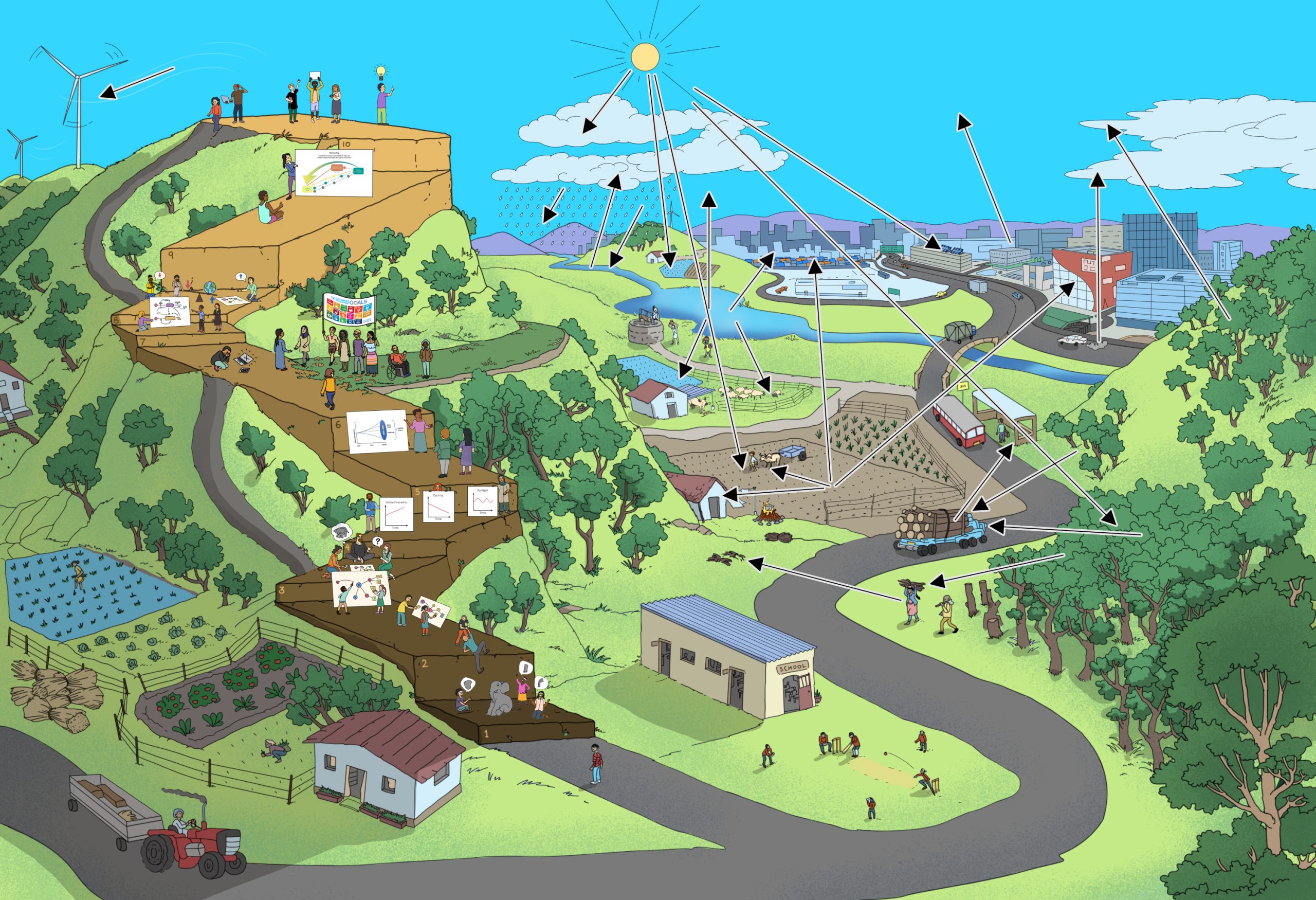Systems thinking is the ability to describe and/ or visualize a part of a complex reality, express that part of reality as a model, understand the model as a system, use the model to explain the behaviour of the system, anticipate the behaviour of the system, and evaluate its impacts on sustainable development, identify potential points of, and types of interventions, generate options to act, assess their impacts in the frame of sustainable development, and decide whether further actions are necessary or not.
What is the aim?
To enable learners to:
- Gain knowledge about different approaches to measuring development such as GDP, HDI, Ecological Footprint and 2030 Agenda
- Understand which measuring system is appropriate to develop an idea about the sustainable development of a state or society.
- Assess different aspects of the cotton and jeans production system as sustainable or unsustainable.
- Evaluate whether the modelled system of cotton production and jeans economy is contributing to the sustainable development process of society or not.
- Evaluate the current and future behaviour of selected parameters for their impact on sustainable development.
Activities, tasks, and suggested learning methods
Note for the facilitator This step is quite ambitious since the learners have to get familiar with concepts of measuring wealth, development and sustainability, decide on the appropriate concept and adapt that to evaluate the contribution to sustainable development (or otherwise) from the contemporary cotton and jeans production systems. Therefore, it may be helpful for if you conduct some preparatory activities around sustainable development before adapting this to the Jeans systems context.
Part 1 – Introducing Sustainable Development
- What is sustainable development?
- The learning method “Indicator Eggs” engages leaners in discussing short case studies to understand human well-being and environmental quality as part of the foundations of sustainable development.
- Information sheet “What is Sustainable Development” introduces a joint consideration of the Ecological Footprint and Human Development Index, as two dimensions of sustainable development
- Worksheet “Measuring Development”introduces different approaches such as the GDP, HDI and the 2030 Agenda
- You may also ask learners to view and analyse videos on sustainable development, such as
- The Story of Stuff
- A video on the “2030 Agenda” Transitioning from the MDGs to the SDGs
- On the SDGs Sustainable Development Goals: Improve Life All Around the Globe
- Nations United: Urgent Solutions for Urgent Times | Presented by Thandie Newton
- How best to measure (sustainable) development?
- Use the Worksheet SDGAnalysis Matrix to identify a suitable key to measure development and sustainable development.
- Study the four suggestions to measure (sustainable) development.
- Fill the analysis matrix and find your individual rating.
- What is the aim of the “2030 Agenda”?
Match pictures with SDGs.
- Print out photos of a range of human activities. You may like to check the pool of selected photos available at this link. You can choose and print out one or more sets, depending on the number of learners. Resources .
- Next, ask learners (working in groups) to choose two photos for each SDG – one, which from their point of view demonstrates a valuable contribution to an SDG, and another which demonstrates a counterproductive contribution to the aims of the respective SDG.
- A picture may fit well with multiple SDGs; the groups should justify their reasons to place it in a specific SDG.
- Distribute the selected photos on the floor.
- Invite a group of two learners to identify pairs of pictures, which are linked to selected SDGs and representing either a valuable contribution or a counterproductive contribution to the aim of the SDGs.
- Invite each group to share their discussions and reflections and to present the final results of their matchings.
Note: You may want to add or choose other photos from your own photo pool or resources on the internet. Pexels and Pixabay are two possible sources of photos https://www.pexels.com/ and https://pixabay.com/
Part 2 – Sustainability of the Jeans system
Building on Part 1, the tasks below would help learners apply their understanding about sustainable development to the Jeans System.
What is sustainable and what is not sustainable?
- Work with a partner and decide which activities are sustainable and which are unsustainable by using the Worksheet on Cotton: Sustainable or Unsustainable
- Give reasons for your decisions.
- Name up to four more activities that can be deemed more or less sustainable or unsustainable.
- Compare your results with your partner and discuss.
Is contemporary cotton and jeans production contributing to the SDGs?
- Work with the Worksheet SDG Analysis Matrix.
- Analyse which elements in the Jean systems contribute to a specific SDG or does not match with the SD goals.
- Write your conclusion in column one and two.
- Identify dilemmas which might emerge by trying to reach one SDG and have negative effects on another.
Suggested Methods
Further leading questions
- Is it possible to change a system?
- How can I change the contemporary Jeans system towards more sustainability?
Example
| Cotton: Sustainable or Unsustainable | |||
| Sustainable | Activity | Unsustainable | |
| – Increase in farmers’ income
– Likely increase of income for rural poor |
To irrigate the enlarged cotton fields, the water supply is increased annually.
|
– Too much water might be taken out of a fragile ecosystem of a semi-arid region with destructive consequences for regional flora and fauna | |
| – Might improve the livelihood of rural poor with positive consequences concerning nutrition, health, education and others. | The fact that the cotton production industry will grow might create even more jobs than today in this economic sector. | – An increasing cotton industry needs more cotton production. More agricultural land will be used for cotton production with a trend towards monoculture and all its negative ecological consequences, especially related to degradation of soil
– Likely increase in use of agrochemicals, higher costs and negative ecological impacts |
|
| – Economic success
– Higher income – Better livelihood – … |
Modern cotton production depends on the use of specific seeds in combination with fertilizers.
|
– Risk of non-biodegradable substances in the ecosystem with unknown consequences | |
| – Less negative ecological impact on soils and adjacent natural areas
– Healthier products – Possibly higher prices – If the global market accepts higher prices for organic cotton, the farmers will have a remarkable improvement of their livelihood |
Production of organic cotton will increase in the next 10 years.
|
– Likely smaller production rate and less income with consequences for economic and social issues of the farmers household
– An increasing cotton industry needs more cotton production. More agricultural land will be used for cotton production with a trend towards monoculture and all its negative ecological consequences, especially related to degradation of soil |
|
| – Greater economic success with positive consequences for farmers’ livelihood | Huge monoculture production of cotton weakens the soil fertility which leads to an increasing use of agro-chemicals. | – Clear unsustainable impact of this agricultural model | |
| – Easier working conditions for farmers and laborers
– Better health |
Increasing use of technology leads to improved workers conditions.
|
– Loss of income possibilities
– Increasing poor |
|
| – Greater economic success with positive consequences for farmers’ livelihood | The Future need of cotton can only be satisfied with GMO cotton.
|
– Risk of non-biodegradable stuff in the ecosystem with unknown consequences | |
| – Easier working conditions for farmers and laborers
– Better health |
Increasing use of agro-technology saves money and lowers the expenses for the producer.
|
– Loss of income possibilities
– Increasing poor |
|
| – Increasing income possibilities with positive consequences on the economic and social dimensions of development | Cotton exports improve the economic situation of countries like India and strengthen their social development. | – Might cause dependencies on a few market products
– Uncontrolled risks of socio-economic development |
|
| – Possibly higher prices
– If the global market accepts higher prices for organic cotton, farmers will have a remarkable improvement of their livelihood |
Fairtrade cotton offers better income and living conditions for small scale farmers and laborers.
|
||
|
|
|||
|
|
|||
|
|
|||

